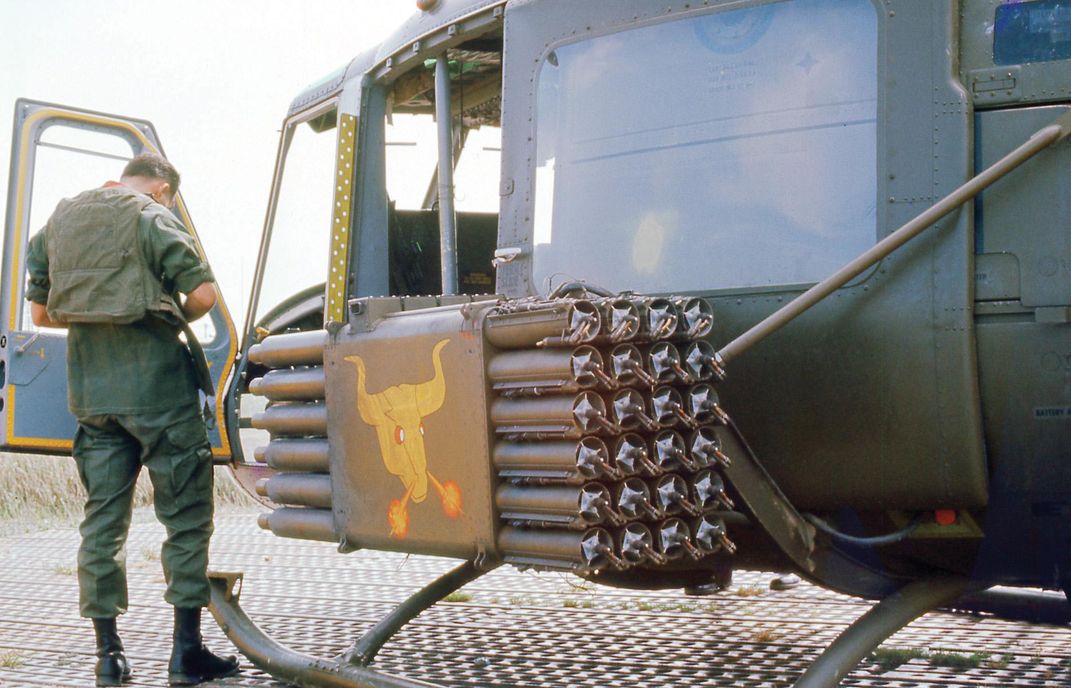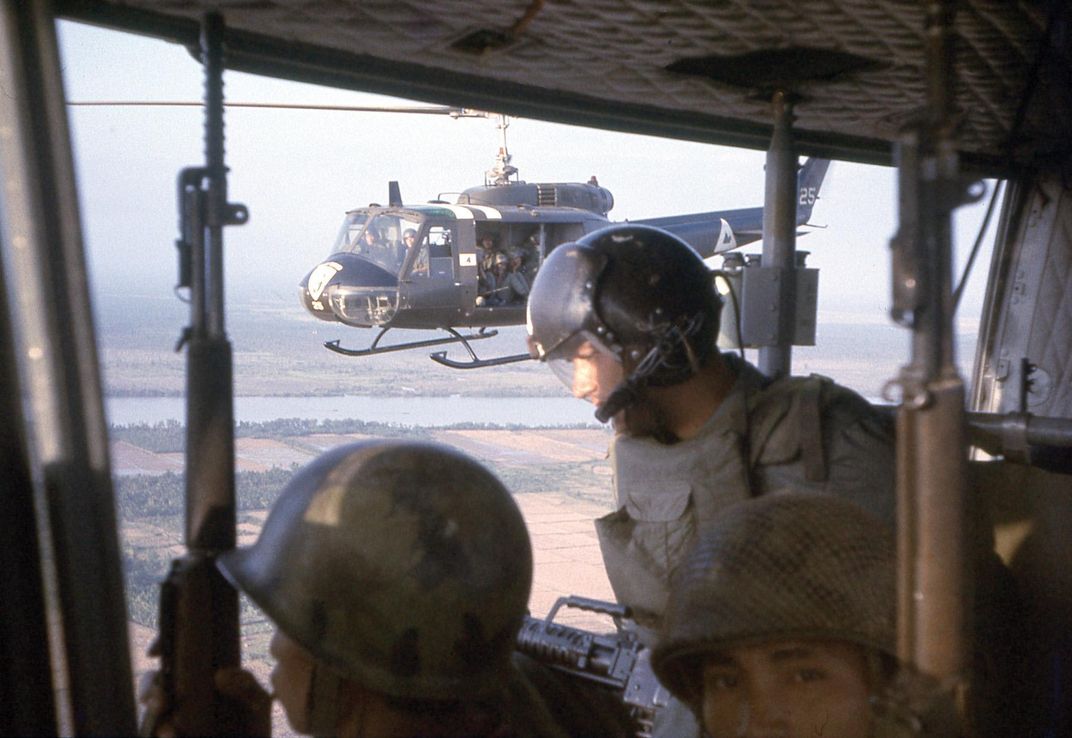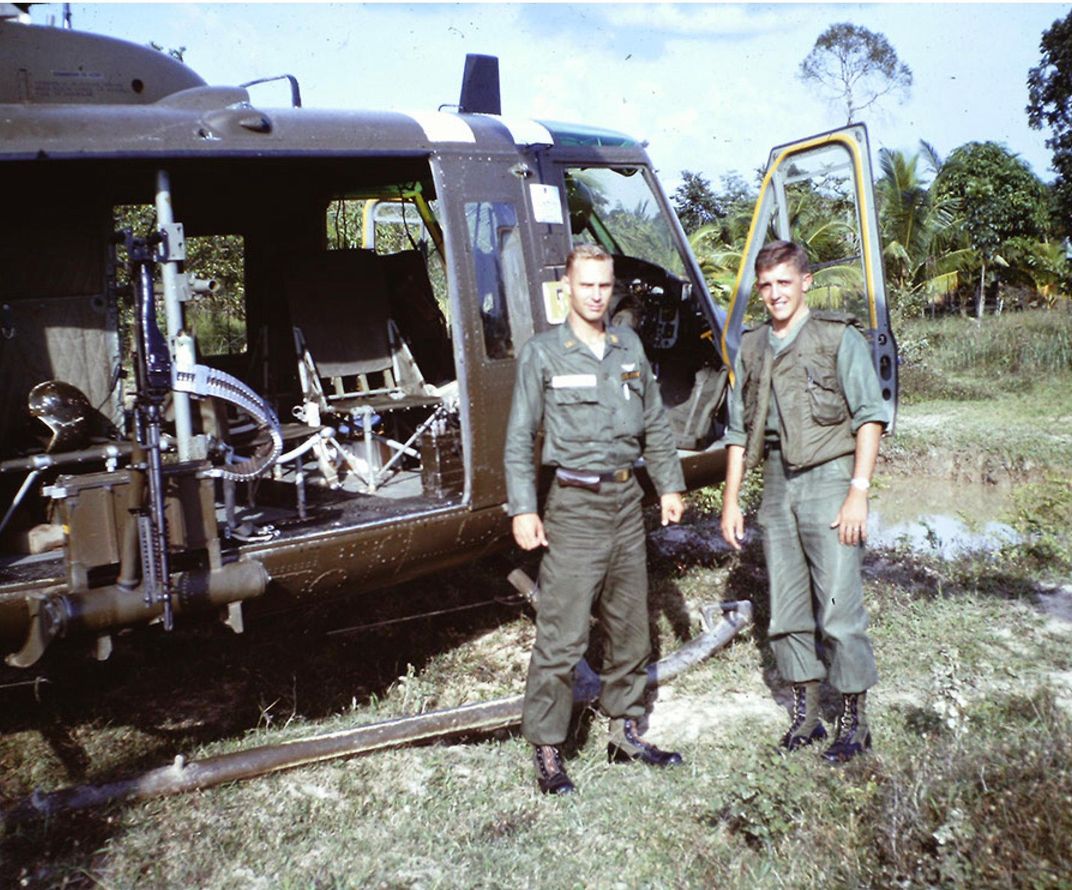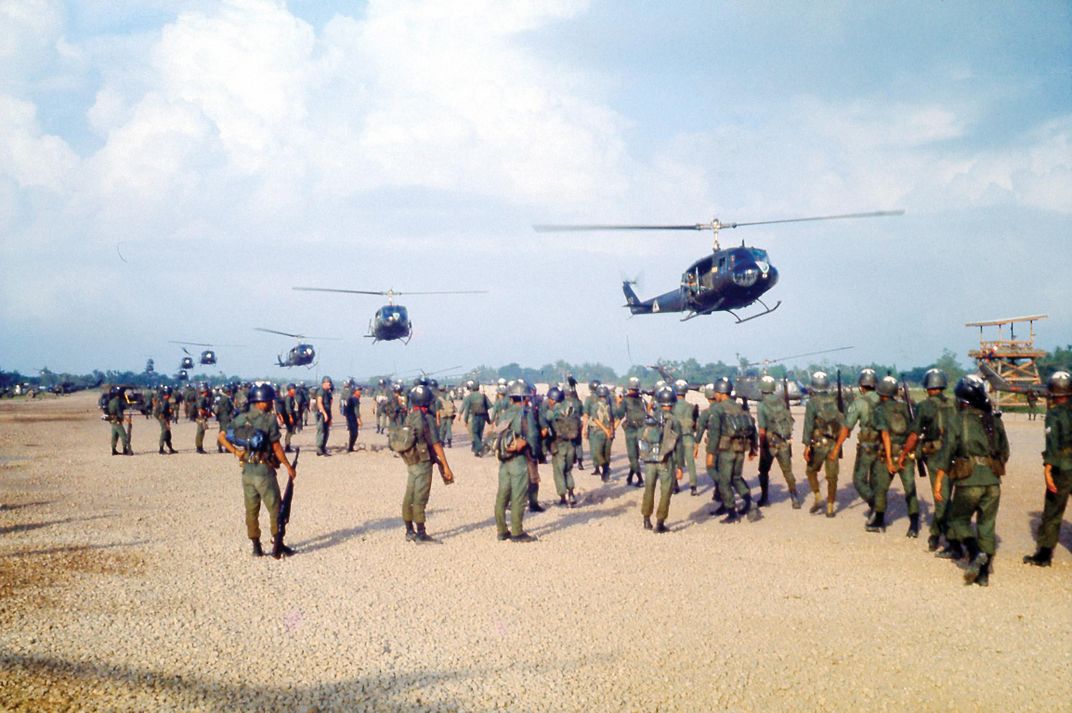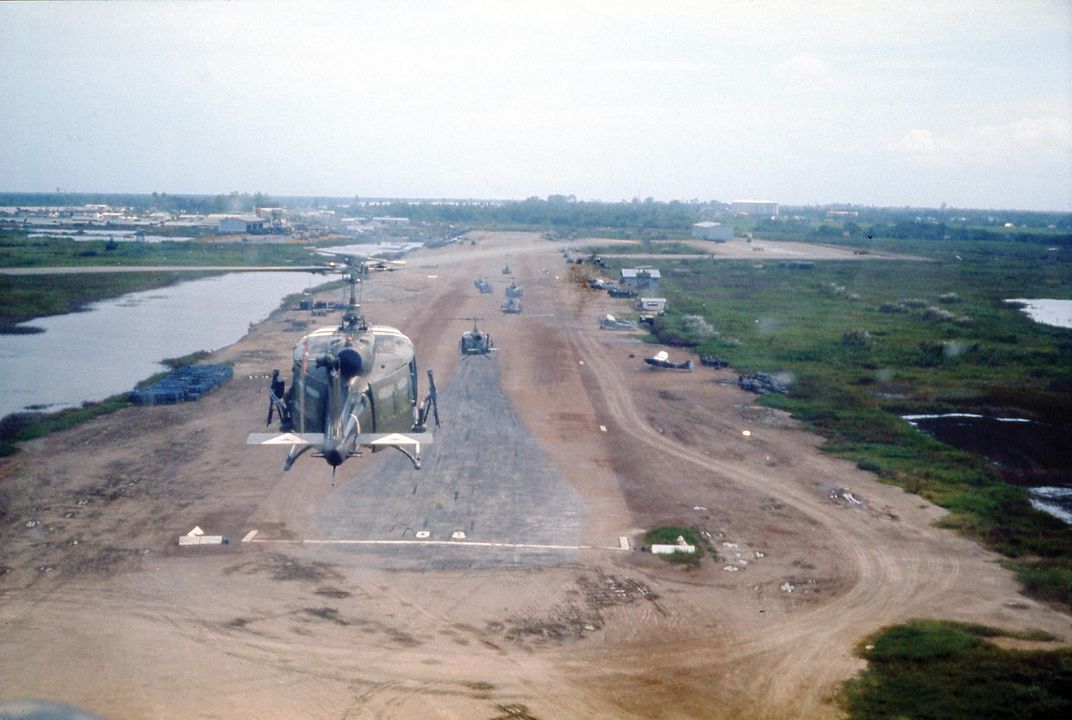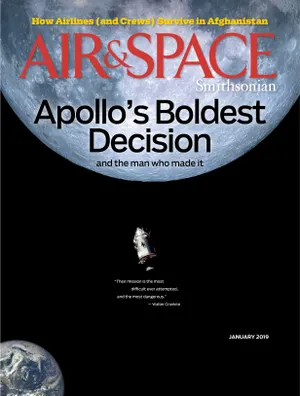Easter Sunday at Vinh Long
From a long war, veterans of the 175th Assault Helicopter Company will never forget one awful day.
/https://tf-cmsv2-smithsonianmag-media.s3.amazonaws.com/filer/78/0e/780eda1f-3b3c-4857-bd08-78fdc33539e1/36c_dj2019_eastersundaybattledavideastmancda002_live.jpg)
It’s a Saturday night at a former Army-base auditorium in Mineral Wells, Texas, where two dozen men aged 70 and upward have stood to join in a song first performed in 1965. The chorus emerges with particular energy, as they sing the words Eric Burdon and the Animals sang that year: We gotta get out of this place / If it’s the last thing we ever do.
They don’t mean this place; they’re happy to be here. This is a reunion of the 175th Assault Helicopter Company, Vietnam edition. Over half of them are pilots, which means they started their Army rotorcraft training in the dry hills and fields around the town’s Army Aviation facility, Fort Wolters.
The “place” they’re thinking of tonight is a paddy in Vietnam’s Mekong Delta, and this second night of their reunion is precisely 50 years after an unusually protracted daytime fight broke out there. It began with a platoon of Army helicopters landing among two well-hidden, well-armed battalions of Vietcong soldiers. In the many hours of fighting that followed, four helicopter rescues were attempted. Half a million machine-gun rounds were expended, along with hundreds of bombs. More than 200 men died, most of them Vietcong. But the Vietcong shot down three helicopters and sent more to heavy repairs.
For all the carnage, the fight rates only a few lines in the war’s reference books. If mentioned at all, it’s as part of Operation Long Phi 999G. But to these men it will always be the Battle of Easter Sunday.
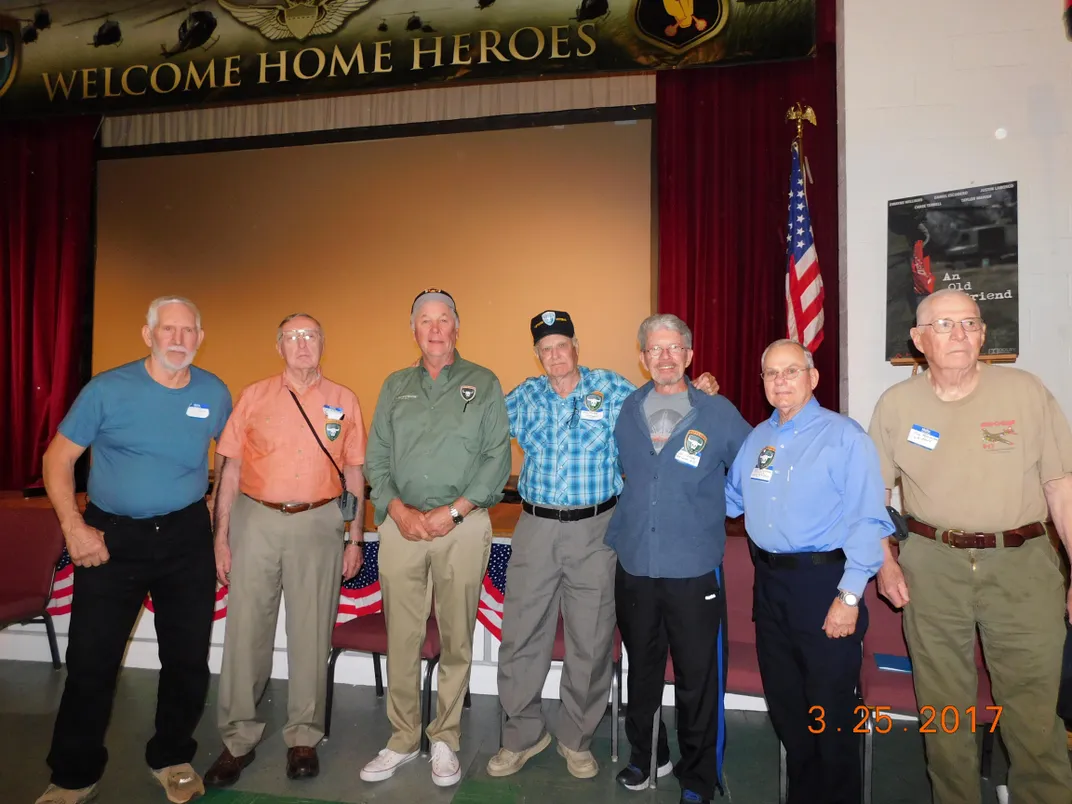
Several of the men wounded that day haven’t seen each other since what one of them calls the “day of the guns.” Fifty years ago. Why so long?
A variety of veterans groups like the Vietnam Helicopter Pilots Association help organize regional and unit gatherings, but a battle reunion is harder to muster. Battles cross multiple commands, from medical evacuation to gunship escorts to troop carriers to American military advisers. And for some, the memory is still too fresh.
“Some of the guys have had trouble dealing with the memories,” says gunship pilot Dwayne “Willie” Williams. “This kind of combat, there’s nothing else that can relate to it.”
In the parking lot outside the rec hall, two Huey helicopters rest on trailers. They are also veterans, their service attested to by patched bullet holes. One is a troop-carrying “slick” and the other a gunship. The latter bristles with simulated rocket pods, garlands of grenades, belted ammunition, and machine guns.
That’s the big stuff. Inside the building, dozens of display boards exhibit assault rifles, knives, banana clips, rocket-propelled grenades, helmets, badges, battle flags, and clothing. One board is devoted to business cards from nightspots like the Princess Bar, 140 Tu Do Street of Saigon, featuring Attractive English Speaking Hostesses and Cold Drink at Moderate Prices. The displays trigger conversations in this crowd of vets and family members. Many of the boards feature American and “Commie” gear hanging side by side. “All this VC gear makes me scared to come in here at night,” jokes Ron Petty, who in 1967 was a warrant officer pilot.
“What struck me that day,” door gunner Joe Watson tells me at one of the banquet tables, “was how first one helicopter got in trouble, then two, then three—and then you’ve got bombers and jets and it kept on going all day long.” After a bit, Watson asks if I’ve seen a fellow named Jon Myhre at the reunion yet. Myhre had been the commander on Watson’s helicopter, and he hadn’t seen Myhre since they parted ways on that battlefield so long ago.
He’s referring to Warrant Officer Jon Myhre, a soft-spoken man with the demeanor of a retired Sunday school teacher. During the battle, Myhre was shot down twice, then burned in a fire. That was just the start of what would be one man’s very long day.
The 175th and another assault helicopter company, the 114th, were based at a French-built facility dating to 1937 at the riverside city of Vinh Long. The base was in a steamy, swampy area of the Mekong Delta, southwest of Saigon. “It was a lot better than the typical tents and airfields,” said Terry McDowell, Myhre’s roommate at the base. “It had semi-permanent structures, which gave us a heightened sense of security from the infrequent mortar attacks.” And unlike most Vietnam billets, it had unlimited hot water.
Along with two other companies based about 60 miles south, at Soc Trang, the assault companies at Vinh Long fell under the command of the 13th Combat Aviation Battalion. Helicopter crews knew it as Delta Battalion, the Shield of the Mekong. The 175th fielded two platoons of UH-1 Huey D-model transports, the slicks, and one platoon of older Huey B-model gunships. The company’s slick platoons called themselves Outlaws; the gunships’ call sign was Maverick.
In 1967, Easter Sunday fell early on the calendar: March 26. No major operations were scheduled, so the duty roster was short and Myhre, aircraft commander of the Huey transport Outlaw 17, planned to sleep late that morning. The coming week looked to be a good one, by Vietnam standards. In just two days, Myhre would be in Hawaii, where he’d meet his wife and infant daughter. Many pilots serving in Vietnam at the time were new to the uniform, but Myhre had enlisted six years earlier as a Marine, later winning permission to train for the Army’s helicopter wing.
He awoke that morning to hear that a full airlift had been ordered, and he was due on the flight line. A battalion of Army of the Republic of Vietnam (ARVN) troops and their advisers were on their way by truck to Vinh Long. Once they arrived, the Outlaws of the 175th would load them aboard 10 Hueys and fly them to a spot near Hoa Binh, a village in the Delta, where they were to intercept a Vietcong force. Moving the full battalion—about 200 men—would take two round trips, or “lifts.” Gunship escort would come from a different company, the Thunderbirds.
Crews called such orders “hurry-up missions”—not quite routine but certainly within their quick-response capability. The main job of U.S. Army Aviation helicopter companies in the Mekong Delta in 1967 was the protection and transport of ARVN troops. Despite what is portrayed in American-made movies about the Vietnam War, in which GI’s travel by chopper to walk into firefights and booby traps, at this time and place, ARVNs and a handful of American military advisers did most of the footwork around the Delta, hunting Vietcong soldiers allied with the communist forces of North Vietnam. Battles could be nightmarish. The Vietcong had been fighting foreigners for decades—Japanese, French, and now Americans—and had adapted to each adversary’s weapons and tactics, though at a heavy cost in lives.
If and when the ARVN troops succeeded in pinning down the elusive enemy, they could call in artillery fire, fighter-bombers, helicopter gunships, and Spooky, a Gatling-gun-equipped AC-47 that appeared by night, hurling fiery streams of projectiles at the enemy. But the ARVN had to find them first—before the Vietcong struck.
This particular operation was intended to set the ARVNs down where they could catch a Vietcong force making for the village of Hoa Binh, a long, narrow community between two small waterways that fed into the Mang Thit Canal. The Mang Thit was fringed by trees that offered cover to enemy gunners, so it was vital to catch the Vietcong before they reached shelter.
By 7 a.m., the crews at Vinh Long were starting the turbines for the short hop from revetments to the airstrip, where the ARVN would climb aboard. Because Myhre reached the operations hooch after everybody else, they had run out of the compact medical kit and emergency radio ordinarily issued to pilots, and he climbed aboard Outlaw 17 without either one. His copilot that day was Jim Martinson. “This was Jim’s first combat assault,” Myhre recalls. “I said, ‘It’ll be a piece of cake. I’ve done this hundreds of times.’ ”
“Thirty seconds is all it takes to land troops,” says Dwayne Williams, “if nobody is shot down.”
Such speed was possible because the transports would be arranged in a formation that allowed them to touch down simultaneously. That day—clear, with just a touch of haze—there would be two five-ship “V” formations, Gold in the lead “V,” followed by White. The ship piloted by Myhre and Martinson would be White Four, slotted into the rearmost, right-hand position.
Now packed with 10 or more soldiers apiece, the Outlaw helicopters lifted from the airstrip at Vinh Long and flew southeast to an aerial staging area, where a pair of Thunderbird gunships waited to guide them to the landing zone, or LZ.
High above the LZ, four more helicopters orbited. One had the radio call sign Delta Six, “six” designating a commander. It was flown by Colonel Jack Dempsey, head of the Delta Battalion. Dempsey hadn’t equipped himself with a flak jacket, not expecting to get within rifle range of the landing zone. Another was Outlaw Six, the ship carrying Major Bill Meehan, commander of the transports. A third Huey had the call sign Dustoff, a medevac helicopter from the 82nd Medical Detachment. A fourth was the flying repair shop from Vinh Long dubbed Roadrunner.
Pilots recall an unsettling change in plans at this time. Though the gunships had marked the original landing zone with smoke, the lead transport pilot received orders to overfly it and land almost a mile further east. The orders worried Outlaw commander Meehan, because the new LZ would put the transports closer to an area not yet reconnoitered.
“That LZ was put right next to where the VC were having their breakfast,” says Dwayne Williams.
After two Skyraiders dropped one ton of bombs on a tree line near the new LZ, gunships of the Thunderbird company flew low in front of the trees, figuring that any lurking enemy would start shooting. Nothing. So, escorted by two more Thunderbirds, the 10 loaded Huey transports approached, heading due east. Shortly before the touchdown, a “smoke ship”—a Huey equipped with a tank and pipes that injected oil into the turbine exhaust—started to lay down a smoke screen.
As soon as the transports fluttered to a landing, the gunfire commenced. One of the first hit was the smoke ship. Its smoke equipment disabled, it gave up on laying down the screen and departed.
Traveling by boats on the feeder canals in order to hasten their retreat from the north, the Vietcong had beaten the helicopters to the LZ. Hoa Binh wasn’t just a waypoint along an escape route. It turned out to be the destination, a strongpoint crammed with bunkers, tunnels, observation posts, spider holes, and machine-gun nests. The VC had connected these installations with miles of field-telephone wire. In addition to the usual AK-47 assault weapons, the strongpoint defenders had hard-hitting BAR automatic and sniper rifles, B-40 grenade launchers, and at least two .50-caliber machine guns in well-concealed positions.
As the 200 ARVN troops and their two American advisers spilled out of the helicopters, the Vietcong mowed them down. The copilot in Outlaw 29, 19-year-old Vance Shearer, took a round to the helmet that knocked him out. He slumped across the controls, almost flipping the ship before the aircraft commander, Tom McCarthy, got control. Gunner Gary Wilcox was shot in the forehead; after a few hours, he died. Bill Meehan called down from Outlaw Six: “Outlaws, get out of there!”
At the rear of the second formation, Outlaw 17’s engine quit and the controls froze. Large-caliber bullets punched holes in the windscreen. “I remember what Jim’s face looked like when it was hit,” Myhre says. “There was blood all over. Then, the next instant, it was like I’d been hit with a baseball bat. My leg flew over the instrument panel—I hit Jim in the head with it.” The impact shattered several inches of Myhre’s right femur. Outlaw 17 settled into the mud, upright—and alone. The other helicopters had all managed to lift off, and the Vietcong gunners gave 17 their full attention. A B-40 rocket opened a hole in the side.
“Think of one duck on a pond with dozens of hunters,” says Jim Martinson.
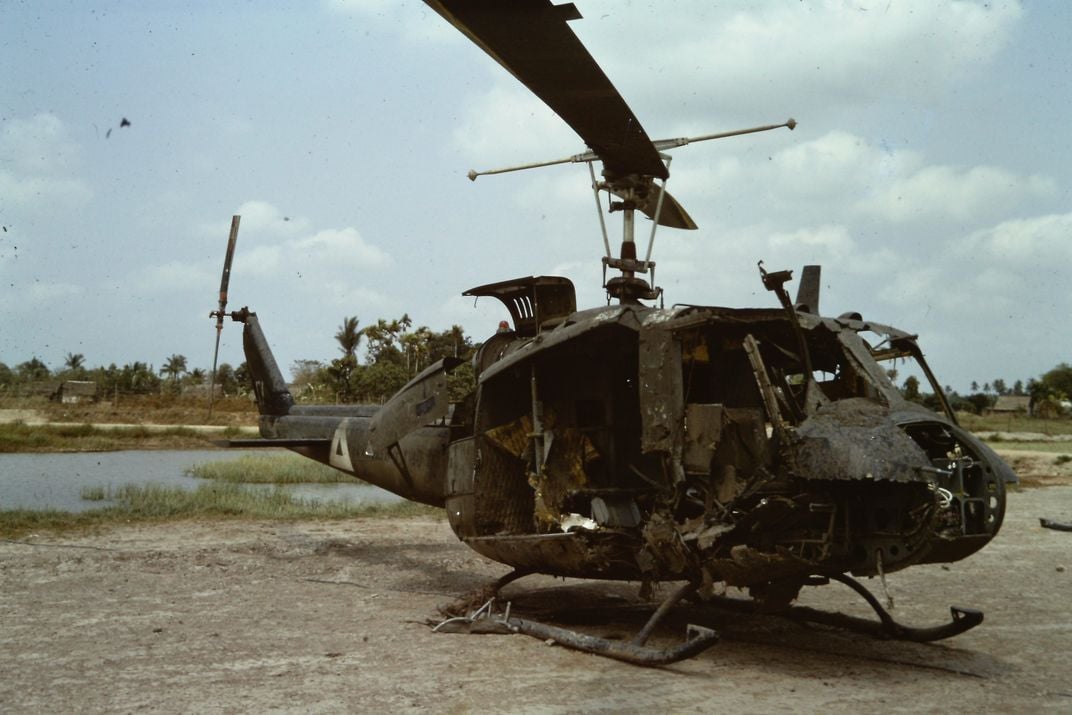
As the first distress calls went out, Major Jim Eberwine, commander of the Dustoff, was already on the way down. Relying on gunship escorts to shoot up the tree lines and throw off the Vietcong aim, he started a descent so steep and fast that Myhre’s Huey had barely settled after the crash before the first rescue attempt began.
“I heard a helicopter approach, 50 feet over our heads, and it was spraying gas all over from the hits,” Myhre recalls. “Now all the tracers were aimed at the Dustoff, not us. He set down tail to enemy, 75 feet away. Joe [Watson, 17’s gunner] grabbed me by the collar, saying we need to get in there. Then both of us were hit. It flipped me in the air. But Joe never let go.” Now Myhre had a second wound, this time in the back. The bullet stopped a fraction of an inch from his spine.
Seeing the Outlaw crew’s painful progress, crew chief Mike Kelley and medic Bill Hook jumped out to help. A VC gunner drew a bead on Dustoff co-pilot Charlie Jordan, but a chest protector relocated behind his head blocked three well-placed bullets.
While helping the Outlaw survivors, Kelley was shot. He made it back to the helicopter but died before he could board. Among the enlisted men, Kelley had stood out: An all-state football player in high school, he had turned down a generous college scholarship package to enlist. Now he lay dead in a rice paddy.
As Eberwine pulled the Dustoff’s collective lever up, preparing to fly forward to gain speed and altitude, a bullet crashed through the chin bubble and hurled his left leg onto the right torque pedal, putting the ship into a tight turn. “You’ve got it,” Eberwine yelled to his copilot, Charlie Jordan, but before Jordan could counter the turn, a skid caught the ground and the helicopter rolled onto its side, flinging chunks of rotor blade. Fuel spilled and ignited.
It was Myhre’s second crash of the morning. The rollover left him dazed at what was now the underside of the helicopter, his arm pinned between the paddy mud and the half-sunken door frame. “After it crashed, I was unconscious,” Myhre says. “My right arm was pinned and I didn’t know where the hell I was. Then somebody yelled ‘fire,’ and that took about a millisecond to register. I looked straight up the deck, knew I had to get out, and started digging to get my arm free.”
Joe Watson and the other survivors of the crash were already out and trying to find cover behind the low paddy dikes. Army Captain Tom Mitchell, one of the American advisers to the ARVN troops being transported, came up to assist the medic, Hook. Now Mitchell dropped, mortally wounded from a gunshot. He had been a vital player in getting the situation under control, and his loss almost doomed the Army airmen.
His arm freed, Myhre crawled up the seat backs of the Dustoff, dragging his useless leg. He tumbled out the high side and landed in the mud. A pool of spilled fuel had caught fire and in navigating the Huey’s interior, Myhre’s leather flying gloves were burned off, leaving only rings of leather around his wrists.
Alone now, he crawled a few dozen yards from the wreck then stopped, utterly spent, lying flat among the rice plants for cover. He had managed to make himself less of a target for the Vietcong, but he was also without a weapon, a medical kit, or an emergency radio handset.
“I screamed out for my crew and those on the Dustoff, but no word came back,” Myhre says. “So I assumed everybody was dead, and I’ve got to survive.”
He decided that sitting up to look around was not an option. Every time he showed a hand or head, he attracted rifle rounds from the tree line. “I waited another 15 to 30 minutes, then tried again, then pop-pop-pop,” he says. “The SOB did that all day long. I had a choice to let my leg bleed or get shot trying to stop it. So I opted to let it bleed.” In a rare bit of luck for such a grievous wound, the bullet missed the artery, and the swelling kept the bleeding down. That kept him alive.
A half-mile overhead, Colonel Jack Dempsey in Delta Six, also chief pilot of his command and control helicopter, called on the radio that he would go in for a rescue. Bill Meehan and other pilots tried to talk Dempsey out of the attempt, saying the LZ was too hot. Dempsey only agreed to wait for an incoming pair of F-100 fighter-bombers.
Dempsey’s copilot was Outlaw company’s operations officer, Don Casper, who had come along for what had looked like a routine mission that would allow him to tally some of the flying hours required of officer-pilots. Dempsey dropped closer to the action so he could add suppressive fire from his door guns. Manning the M-60 machine gun at the left door, crew chief Bill Rhodes cradled his belt-fed weapon rather than relying on a door mount or a bungee cord. Rhodes shot at the tree line as the helicopter banked on each pass, even to the point of firing under the Huey’s tail boom.
“Delta Six was adamant he was going to go in,” remembers Dwayne Williams, one of the gunship pilots who followed Dempsey in. “The fire got intense and Dempsey’s call came, ‘I’m hit, I’m going down.’ ”
Rhodes says: “At 250 feet off the ground, all hell broke loose.” Today, Rhodes is a lanky, white-bearded businessman, willing to recount each minute as he saw it. His journey to the reunion was an improbable one. He heard about the event from a customer who came to his northern California sawmill for lumber and in passing mentioned a compilation of battlefield interviews assembled by Jon Myhre.
“I could hear the noise even with my helmet on, the sound of tic tic tic as the bullets hit the aircraft,” says Rhodes. “Then at five feet off the ground, bullets came through the glass while I was watching that side. Dempsey arched up and fell forward.”
Jim Martinson was lying below close to death when Delta Six hit the ground in a spray of mud and water. Now a third helicopter was down in the paddy.
Dempsey’s side gunner Jerry Ross, and later Bill Rhodes and Don Casper, were working to get Dempsey loose from the wreckage when he died. This wasn’t supposed to happen: Dempsey was a combat veteran of World War II and Korea, unstoppable, an O-6, just one step short of brigadier general.
Rhodes applied a tourniquet to Casper, who was losing blood from two arm wounds. Casper also had a bullet in his belly and a chest wound. Most of the survivors from Delta Six’s crash (copilot Casper, crew chief Rhodes, gunner Ross, along with Jim Martinson, Joe Watson, and Mike Kidd from Outlaw 17) found cover on one side of Delta’s wreck, leaving Jon Myhre on the other side. None of them saw Myhre again on the battlefield. Rhodes crawled to an ARVN squad and administered first aid to two soldiers with shrapnel wounds from bombs that had been dropped by F-100s in an attempt to push back the Vietcong.
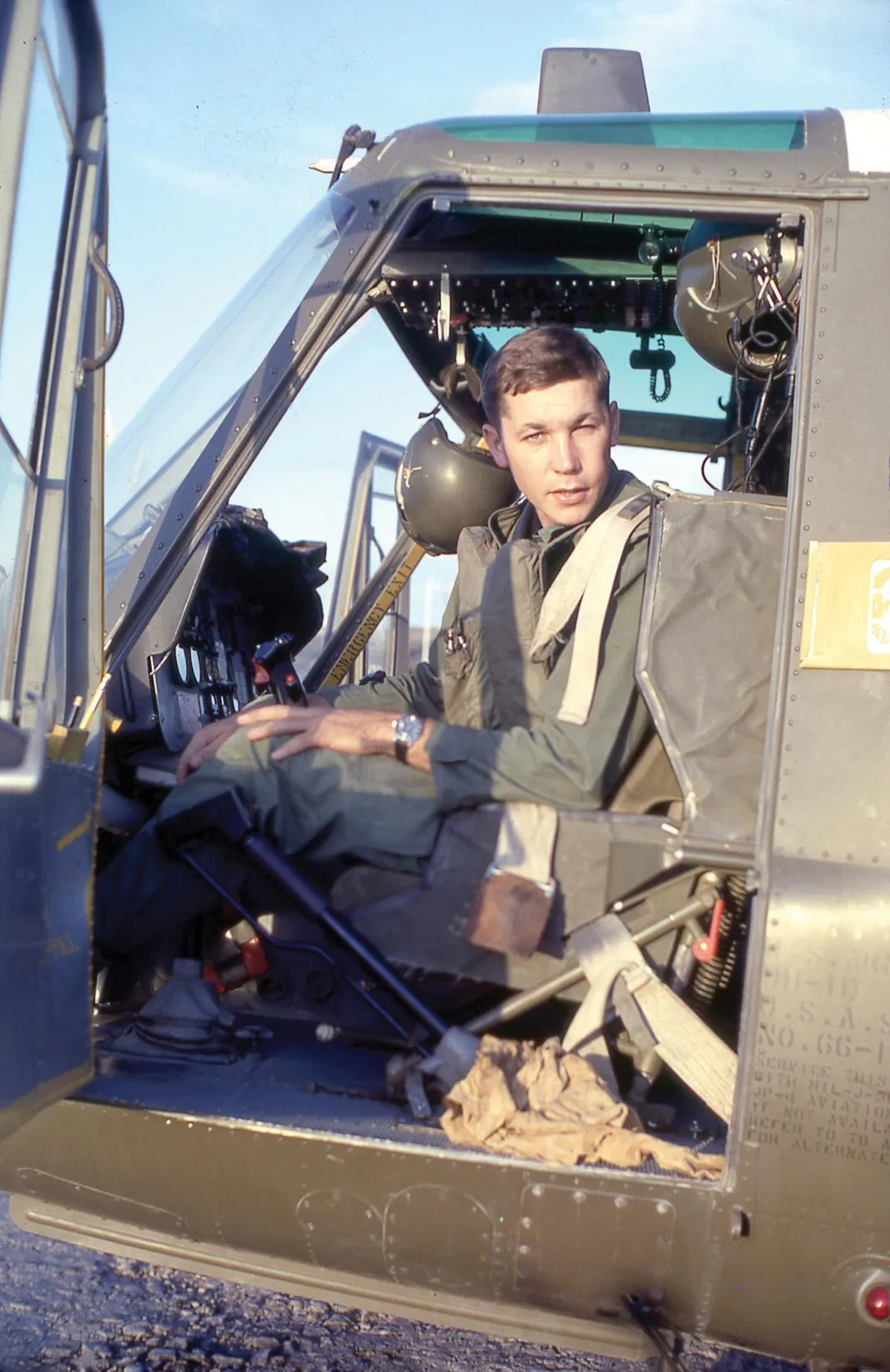
Bill Meehan in Outlaw Six was in command of the scene now, and he ordered a halt to any more spontaneous rescues. The plan now was simply to hold back the enemy until a full rescue effort could be organized.
At this point, officers on the ground and in the air knew little except that the standard cordon-and-sweep tactic had blundered into a lethal trap. Three helicopters crews had crashed under fire, and crewmen were awaiting rescue. Plus, another crew had crash-landed on the way back to base. Several more ships had taken heavy fire from the tree line. Dozens of ARVN troops, perhaps half of all who landed in the first assault, were injured or dead.
This would be no ordinary rescue mission, so commanders weighed three options. One was reinforcement by land from the northwest, relying on a column of ARVN armored cavalry with weapons heavier than anything the trapped troops had, but these would have to cross the Mang Thit Canal and slog through low and flooded land. Another was heliborne delivery of ARVN reinforcements to locations far enough from the battlefield to be safe. If these two didn’t bear fruit by mid-afternoon, a third option was a coordinated multi-helicopter rescue, with lots of fire support that would plummet into the middle of the fight. Whatever the means, it had to succeed before dark, when the Vietcong would control the area. This gave them about six hours.
Aircraft arrived, lots of them, from airfields all across the Delta and as far away as the base at Cam Ranh Bay, 700 miles to the north. Bombers and Skyraiders took turns pummeling the tree lines on the north and east. Dozens of Huey gunships formed a “daisy chain,” like stock cars along an aerial racetrack. One leg of this pattern passed over the Vietcong-held tree lines. As each gunship exhausted its rocket pods, grenades, and ammunition cases, it left the formation and headed to base for more ammunition.
At the Vinh Long airfield, the time to re-arm a gunship dropped from the normal 30 minutes to 10, says Terry McDowell, who managed the reloading. “Most of the personnel on the base showed up at the flight line, so we put them to work.” Pilots refused to give way to others who were off-duty for the day. Gunships were so overloaded that gunners ran alongside as the B-model Hueys scraped along the runway, gaining enough translational lift to claw into the air.
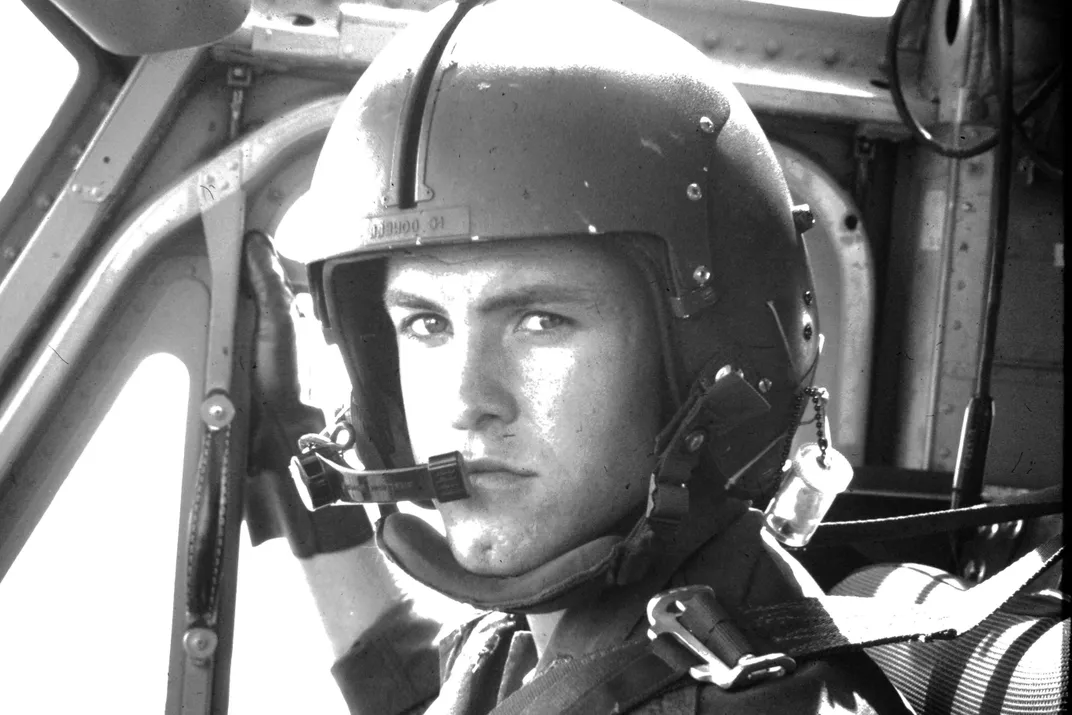
Still the Vietcong gunners were firing—from slits in log bunkers concealed among the dike lines. Snipers were picking off men who showed their heads above the vegetation. Mindful of the opposition, slicks dropped ARVN reinforcements out of rifle range, on the opposite side of a tree line lying a half-mile northwest. Adviser Rex Latham went in search of his senior officer, Tom Mitchell, not knowing his fate. Latham found that he could make his way into the combat zone by staying low and timing his movements with the aircraft attacks, when the Vietcong ducked for cover. Finding Mitchell dead, Latham took his radio and began organizing the remnants of the first lift, grouping the wounded for rescue.
Awaiting the arrival of more troops to take up flanking positions on the east, the new ARVN forces held their advance, still facing heavy fire. Vietcong spotters were using whistle signals effectively: calling the men to take cover when gunships were in sight, then summoning them into action once the airplanes had passed.
As it appeared that the ARVN airlift would not be able to handle the situation, word came that the tracked vehicles in the ARVN’s armored column were stuck in soft ground near the Mang Thit Canal; they wouldn’t arrive before nightfall.
Commanders turned to the third option: a large-scale helicopter rescue. There were too many wounded Americans and ARVNs to fit on a single Dustoff, so three additional crews volunteered to follow it down. One was a slick commanded by Warrant Officer Dave Eastman. Eastman had spent the morning flying commanders back and forth and was eager to help. A second was the unit’s repair helicopter, the Road Runner. Mike Hershey, pilot of the smoke ship that was knocked out of action early in the battle, jumped on as Road Runner copilot. The fourth was commanded by Jüri Toomepuu, a fervently anti-communist immigrant from Estonia who had fought in Korea as an enlisted man.
A fifth helo would be critical to the plan: Viking Surprise, a D-model Huey out of Soc Trang and the only other smoke ship available for combat that day. That ship’s commander was a spectacle-wearing pilot named Jerry Daly.
“I was eating breakfast at Soc Trang, in the Officers’ Club, when the call came,” recalls Daly, today a Catholic priest. He was unable to attend the weekend reunion and shares his memories by phone. “Viking Surprise was the only other smoke ship available in all the Delta,” he says. His crew brought along something that would be good for morale, if not enough for survival: a .50-caliber Browning heavy machine gun, which they aimed out a side door. The Huey’s light frame couldn’t handle the recoil from such a gun if hard-mounted, so Viking’s crew dragged in a mattress and laid it on that.
Given the toll so far in men and machines, Daly’s assignment had the look of a suicide mission. Smoke ships have to fly low and slow, directly in front of enemy positions. If the wind speed was low, Viking Surprise might have to make only two death-defying passes in front of the enemy’s massed fire. Instead, the breeze that morning was too strong for the smoke to hang in place, so Viking Surprise passed again and again, rebuilding the screen.
“After we made six, seven or eight passes we ran out of juice, so we kept going around, shooting the .50,” Daly says. “That was until all the ships got out. That took longer than you might think.”
“I can assure you I’ve never seen anybody fly a helicopter like that before,” Myhre says today.
On the ground, the rescuers were finding it hard to round up their fellow Americans. Pilots Eastman and Toomepuu jumped out to speed the loading.
Joe Watson had been sheltering behind the paddy dike. “I was so stuck in the mud I couldn’t get myself free,” says Watson. “It took two men to pull me out.” No one saw or heard Myhre on the far side of the combat zone, lying wounded in the grass.
The first three ships lifted off with their loads, but the fourth ship, the Dustoff, was too heavy with passengers, which included some ARVN troops. Twice the helicopter failed to gain enough altitude to get over the knee-high dikes. Once the pilot perched his ship on a dike, balanced on one skid. Finally enough men got out to lighten the ship, enabling a getaway.
The most surprising event in the third rescue attempt was, appropriately, the return to base of Viking Surprise. The Vietcong had many opportunities to shoot it down, yet the smoke ship made it back to the airstrip at Vinh Long—barely. Immediately declared unflyable, Viking Surprise was shipped back to the States to be rebuilt. The smoke ship’s five-man crew escaped with only one injury between them, a flesh wound sustained by copilot Larry McDonald from a stray bullet fragment. I ask Jerry Daly how many new bullet holes his ship sported upon landing. He doubts that the count was as high as legend has it—130—“but it was certainly over 50.”
In the noise and confusion of the four-ship rescue mission, and given that many of the survivors were covered in gray paddy mud, nobody knew the results until a headcount at the Vinh Long airfield. One American remained unaccounted for: Jon Myhre. Outlaws knew he had been gravely wounded during and after the crash of Outlaw 17, and nobody had seen him since the Dustoff crash. His wife Ginny got the call: Jon was missing in action and likely dead.
While Dempsey’s death on Delta Six was shocking, the loss of Myhre hit the Outlaw crews particularly hard. Dempsey lived and worked out of headquarters in Can Tho, so the men of the Outlaw platoons rarely saw him in person, but Myhre and his guitar were familiar to all the men at Vinh Long.
Back at the battlefield, the guitarist was still alive and learning about “danger close” bombing. Friendly airplanes were flinging bombs as large as 500 pounds over his head to support the eventual advance of ARVN troops on Hoa Binh. When the warheads exploded among the palms, the blasts heaved the soft ground “like a swell in the ocean,” he says, and rained hot shrapnel on his back. The explosions left him deaf for a half an hour at a time, and as his hearing returned, more explosions restored the ringing in his ears.
Myhre’s fate rested entirely on whether the ARVN ground troops led by Lieutenant Rex Latham, reached him before the Vietcong.
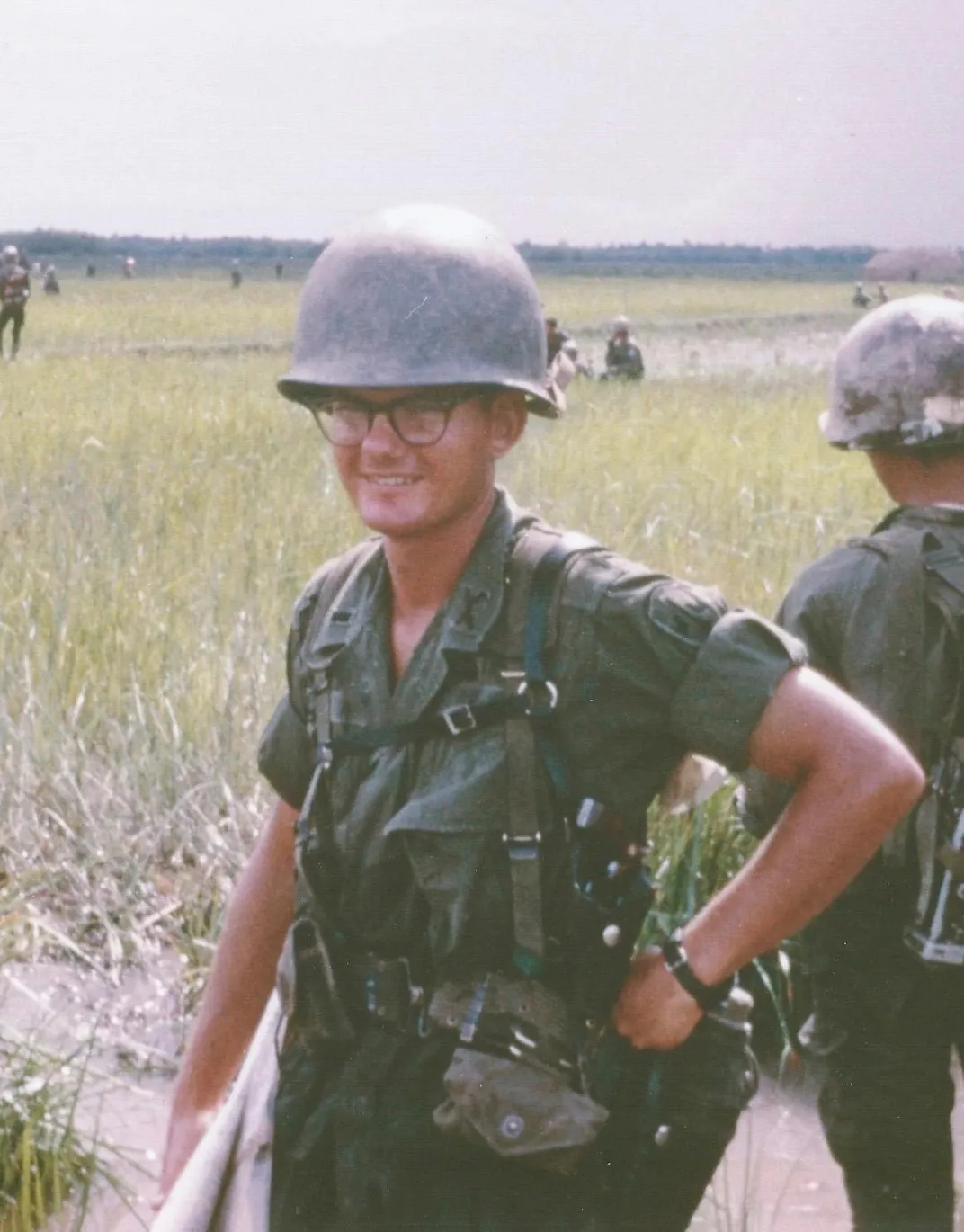
At the reunion, Latham stands out. While many of the attendees might have to struggle to don their uniforms from 1967, Latham, trim with a military bearing, would have no trouble. One of his contributions to the evening program is narrating a slideshow about a return to the battlefield at the 40-year anniversary. On that trip, he says, he talked with a former Vietcong officer. “In 1967, we would have shot each other without a second thought,” Latham tells his fellow veterans and their families, “but in 2007 we talked as old soldiers, just on opposite sides.”
Remembering 1967, Latham says that he didn’t know going in what he and the ARVNs he was advising were up against: elements of two veteran Vietcong battalions, dug in and well-equipped.
The men I spoke to at the reunion were proud that though outnumbered by enemy forces, they had acquitted themselves with honor.
Late that afternoon, as ARVN troops began creeping up on the Vietcong positions, Myhre saw a form approaching and figured it was a Vietcong soldier coming to check bodies for booty. Unarmed, Myhre played dead and prepared to attack. As the stranger picked up Myhre’s arm to pull off his wristwatch, Myhre grabbed the man’s shirt collar, intending to drag him down and kill him with a bite to the jugular until he recognized the ARVN uniform. As Myhre released his grip and reached out to shake his hand, the soldier fell dead from a sniper bullet and tumbled onto his weapon, an M-1 .30-caliber carbine. Myhre guessed the same sniper who had been hounding him all day had killed his rescuer.
Myhre, knowing that the Vietcong would turn more aggressive as night fell, coveted the M-1 rifle. He tugged it from under the soldier’s body and readied it for action.
Before midnight, Latham heard from an ARVN scout that someone who could be American was moving in front of them. Calling out in Vietnamese, Latham approached, found Myhre, and inspected his wounds by flashlight.
Latham passed the news by radio to his commander, Major Andrew Palenchar, and they discussed whether Myhre could live until a daytime rescue. Another voice broke into the frequency: It came from the cockpit of a Spooky gunship orbiting above, which by coincidence had a doctor on board. The doctor’s assessment: Myhre would be dead by morning. A command helicopter passing nearby, on the way to headquarters at Can Tho, overheard the transmissions and agreed to try a risky nighttime landing but aborted after receiving Vietcong fire.
The commander’s gunship escort, Lancer Two of the 114th Assault Helicopter Company, volunteered to make the next attempt. Following Latham’s flashlight signals, copilot Captain Frank Sasaki guided the ship to a low hover touching the paddy’s muddy water. Using a stretcher improvised from rifles and ponchos, Latham and enlisted men lugged Myhre 100 feet to Lancer Two and heaved him in. Myhre rode to Vinh Long atop a lumpy layer of ammo cases.
The word spread through the hooches of Outlaws and Mavericks: Fittingly, it was predawn after Easter Sunday and Jon Myhre was back from the dead.
As the reunion was winding down on Saturday night, Joe Watson, a door gunner on Myhre’s Huey, shared thoughts of their long, uncelebrated journey back from Vietnam. Myhre recalled that his welcome was little more than being trundled out of an ambulance onto the loading dock at Walter Reed Army Hospital.
During the slideshow of the pilgrimage to the battlefield that some of the veterans had made on the 40th anniversary of the battle, Latham showed a photograph of a large monument the Vietnamese government had erected. On one side of the monument, artwork depicts three helicopters going down in flames. At the base of monument, six Americans are smiling at the camera, happy, we can assume, that so many men made it out of that hellish place alive.
After a stay at Walter Reed Army Hospital, Myhre worked as a military courier until cleared to resume flying. He declined a return to helicopters in favor of fixed-wing aircraft. He retired from the Army in 1981. Myhre lived another 51 years after the Battle of Easter Sunday and passed away on October 6, 2018.

